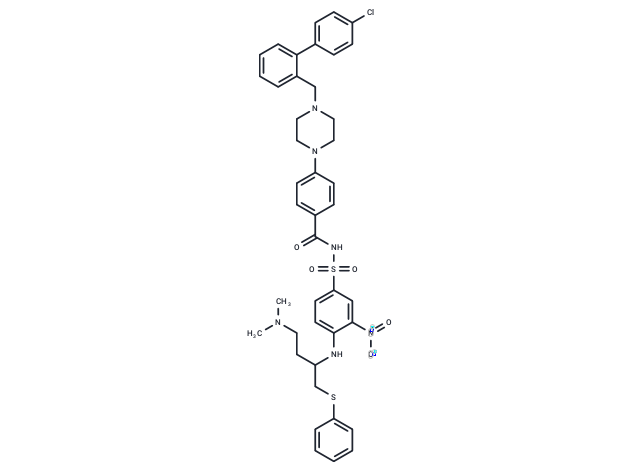Shopping Cart
- Remove All
 Your shopping cart is currently empty
Your shopping cart is currently empty

ABT-737 is a BH3 mimetic and an inhibitor of Bcl-2, Bcl-xL, and Bcl-w (EC50=30.3 nM/78.7 nM/197.8 nM). ABT-737 exhibits antitumor activity and anti-aging activity.

| Pack Size | Price | Availability | Quantity |
|---|---|---|---|
| 5 mg | $64 | In Stock | |
| 10 mg | $77 | In Stock | |
| 25 mg | $139 | In Stock | |
| 50 mg | $247 | In Stock | |
| 100 mg | $433 | In Stock | |
| 200 mg | $638 | In Stock | |
| 1 mL x 10 mM (in DMSO) | $71 | In Stock |
| Description | ABT-737 is a BH3 mimetic and an inhibitor of Bcl-2, Bcl-xL, and Bcl-w (EC50=30.3 nM/78.7 nM/197.8 nM). ABT-737 exhibits antitumor activity and anti-aging activity. |
| Targets&IC50 | BCL-B:1820 nM(EC50, cell free), BCL-W:197.8 nM(EC50, cell free), BCL-XL:78.7 nM(EC50, cell free), BCL2:30.3 nM(EC50, cell free) |
| In vitro | METHODS: AML cell line HL-60 was treated with ABT-737 (10-250 nM) for 24-72 h. Cell growth was detected by live cell counting. RESULTS: HL-60 cells showed high sensitivity to ABT-737 with IC50=50 nM.[1] METHODS: Thyroid cancer cells were treated with ABT-737 (1 µM) for 24 h and cell cycle was detected by flow cytometer. RESULTS: In all five cell lines analyzed, there was a significant increase in cells at the subG1 level, suggesting that ABT-737 induced cell death and DNA breaks.The highest percentage of cells at the subG1 peak was found in ABT-737-treated papillary BHT101 and mesenchymal SW1736 cells (54.8% and 39.9%). [2] |
| In vivo | METHODS: To test the antitumor activity in vivo, Insulin (0.035 mg per mouse) and anti-PD1 (0.25 mg per mouse) were intraperitoneally injected into C57BL/6 mice bearing mouse colorectal carcinoma tumor MC38 every two days for five administrations. RESULTS: anti-PD1 significantly inhibited the growth of MC38 tumors, while Insulin promoted the growth of MC38 tumors. The therapeutic effect of the combination of Insulin and anti-PD1 on MC38 tumor suppression was attenuated compared to anti-PD1 treatment alone. anti-PD1 significantly increased the number of infiltrating CD8+ T cells, whereas Insulin significantly decreased the number of tumor-infiltrating CD8+ T cells. [4] METHODS: To study virus-induced insulin-dependent diabetes mellitus (IDDM), Insulin (1 mg) was administered orally to RIP-LCMV tg mice twice a week for two months. RESULTS: Insulin treatment was effective in preventing the progression of islet infiltration to overt IDDM in pre-diabetic tg mice. Oral administration of Insulin did not affect the production of LCMV-NP-specific anti auto-cytotoxic T lymphocytes or the infiltration of lymphocytes into the pancreas. [5] |
| Kinase Assay | To determine the binding affinity of GST-BCL-2 family proteins to the FITCconjugated BH3 domain of BIM, FPAs were performed as described. Briefly, 100 nM of GST-BCL-2 family fusion proteins were incubated with serial dilutions of ABT-737 in PBS for 2 min. Then, 20 nM of FITC-BIM BH3 peptide was added. Fluorescence polarization was measured using a Detection System after 10 min using the 96-well black plate. IC50s were determined [1]. |
| Cell Research | Cells were seeded into 96-well plates (5 × 10^3 cells/well) and cultured for 12 h at 37 °C, as described above. Then, the medium was replaced with RPMI 1640 containing various concentrations of ATO (1, 2, 4 and 8 nM), ABT-737 (2.5, 5, 10 and 20 μM) or combinations of ATO and ABT-737, and cells were cultured for a further for 24, 48 or 72 h at 37 °C. Cells cultured in RPMI 1640 containing an equal volume of 0.01 M phosphate-buffered saline (PBS, pH 7.4; vehicle) served as controls. Cell viability was measured using Cell Counting Kit-8, according to the manufacturer's instructions. The cell proliferation rate was calculated according to the formula: experimental optical density (OD) value/control OD value × 100%. Experiments were repeated in triplicate [2]. |
| Animal Research | Mice were housed under standard conditions and had free access to water and food, under a 12-h light/12-h dark cycle in a room maintained at 18 – 22 °C and 50 – 65% humidity. SGC7901 cells (5 × 10^6) were subcutaneously inoculated into the right flank of BALB/c mice (H-2b). Tumour volume was measured using callipers and estimated according to the formula: π ? 6 × a2 × b, where a was the short axis, and b was the long axis. After 10 days, when the tumours had reached about 0.2 cm in diameter, the mice were randomly assigned to four groups (n = 8 per group), using a randomization schedule generated by the SAS software package. The groups were: control; ABT-737; ATO; ABT737 + ATO. They received, respectively: vehicle (1% DMSO, 99% 0.01 M PBS; pH 7.4); ABT-737 (50 mg/kg); ATO (2.5 mg/kg); ABT737 (50 mg/kg) + ATO (2.5 mg/kg) intraperitoneally (i.p.) every 2 days. Drugs were dissolved in the vehicle solution. To standardize the experiments, each mouse received a similar volume of solution. After 15 days, the mice were euthanized and the solid SGC-7901 tumours were harvested, fixed with 4% paraformaldehyde, frozen in optimal cutting temperature compound and stored at –80 °C [2]. |
| Molecular Weight | 813.43 |
| Formula | C42H45ClN6O5S2 |
| Cas No. | 852808-04-9 |
| Smiles | CN(C)CCC(CSc1ccccc1)Nc1ccc(cc1[N+]([O-])=O)S(=O)(=O)NC(=O)c1ccc(cc1)N1CCN(Cc2ccccc2-c2ccc(Cl)cc2)CC1 |
| Relative Density. | 1.38 g/cm3 |
| Storage | keep away from direct sunlight,store at low temperature | Powder: -20°C for 3 years | In solvent: -80°C for 1 year | Shipping with blue ice. | ||||||||||||||||||||||||||||||
| Solubility Information | H2O: < 1 mg/mL (insoluble or slightly soluble) Ethanol: < 1 mg/mL (insoluble or slightly soluble) DMSO: 50 mg/mL (61.47 mM), Sonication is recommended. | ||||||||||||||||||||||||||||||
Solution Preparation Table | |||||||||||||||||||||||||||||||
DMSO
| |||||||||||||||||||||||||||||||

Copyright © 2015-2025 TargetMol Chemicals Inc. All Rights Reserved.